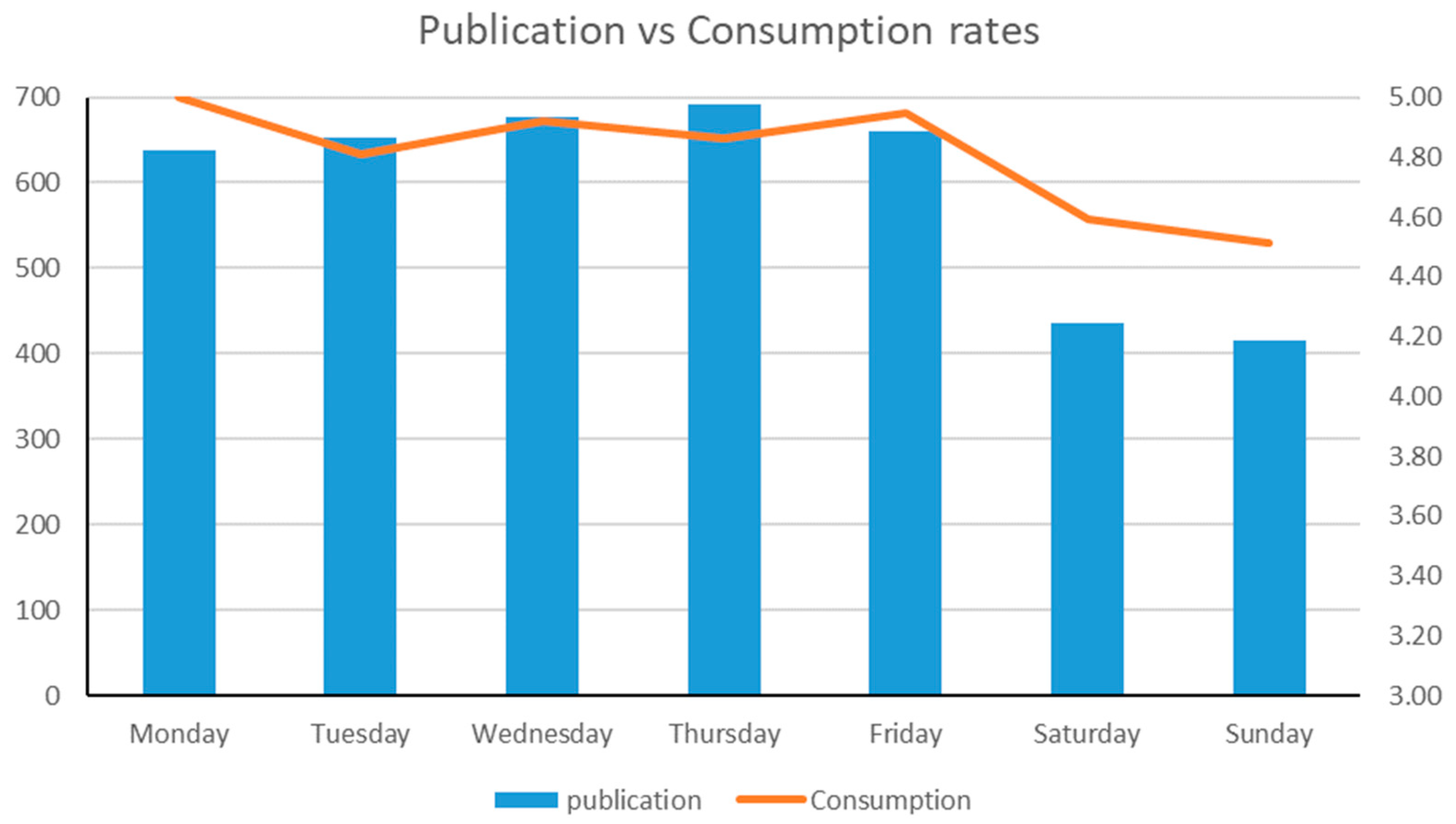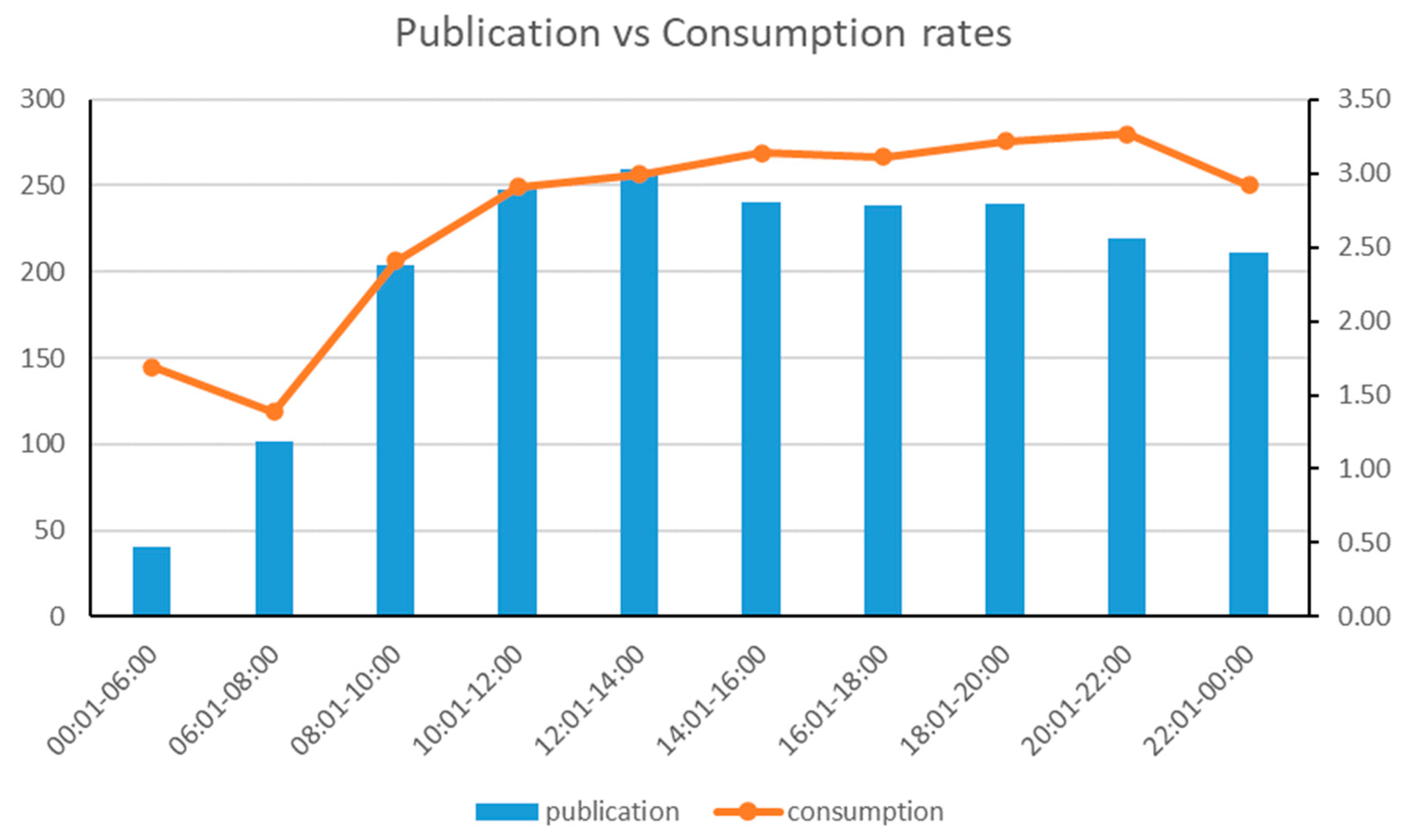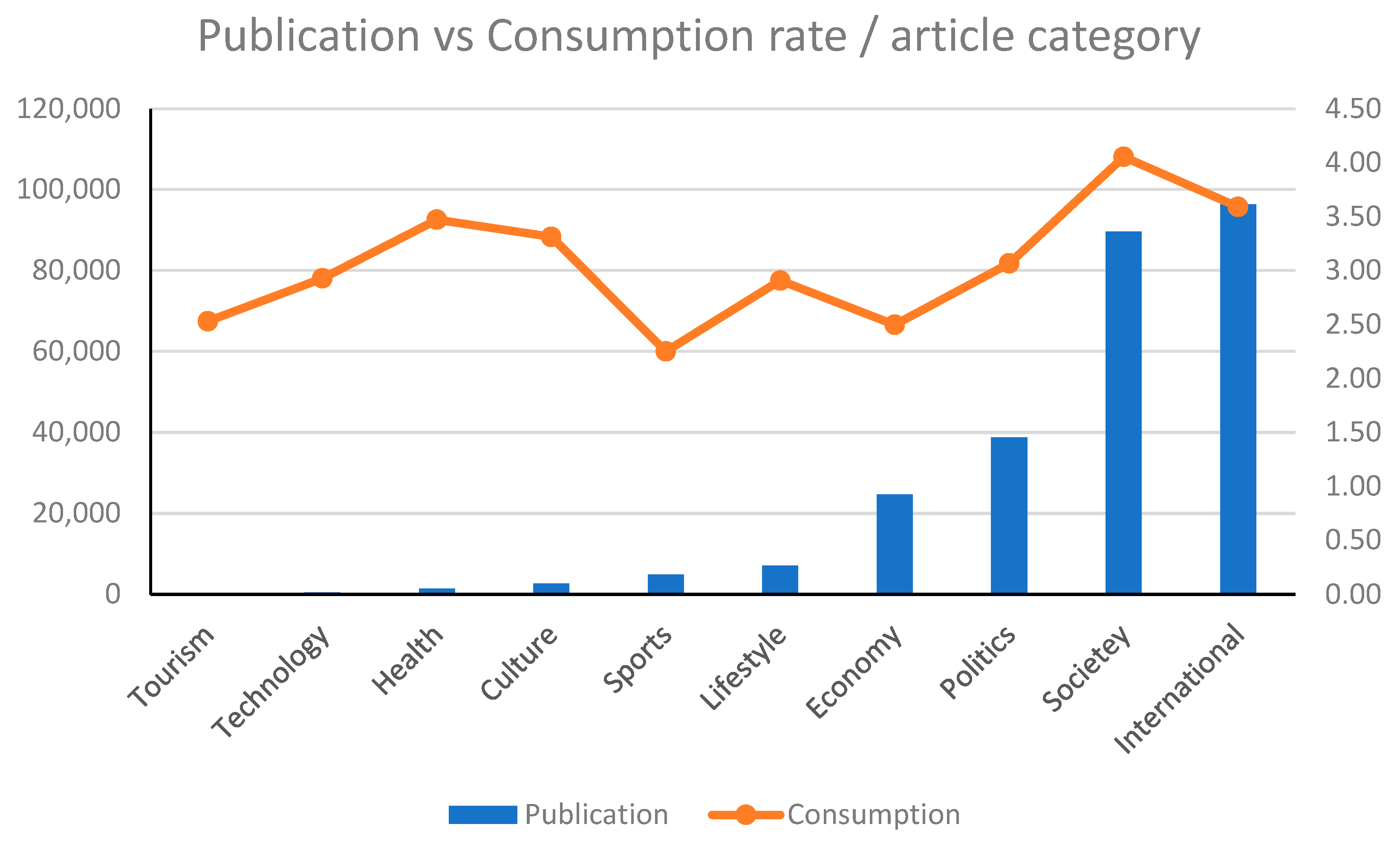Comparison of Publishing and Consumption Patterns in Greek Media Websites
Abstract
:1. Introduction
- Are the publishing patterns of Greek media websites compatible with the audience’s consumption patterns?
- Are there any adjustments that need to be made in order for the publishing patterns of Greek media websites to be compatible with the audience’s consumption patterns?
2. Materials and Methods
3. Results
4. Discussion
- Increase the publication rate during weekends, after 14:00, and also during the night.
- Increase the publication rate of news articles on certain categories (Tourism, Technology, Health, Culture, sports lifestyle).
5. Conclusions and Limitations of the Study
Author Contributions
Funding
Institutional Review Board Statement
Data Availability Statement
Conflicts of Interest
References
- American Press Institute. 2014. Social and Demographic Differences in News Habits and Attitudes. Available online: https://www.americanpressinstitute.org/publications/reports/survey-research/social-demographic-differences-news-habits-attitudes/ (accessed on 7 December 2021).
- Armould, Valerie. 2003. Beyond the Prinded Word: More personalized service offers path to success online. Cover Story. Newspaper Techniques, December 10–13. [Google Scholar]
- Avraam, Evangelia. 2012. Contribution of New Information and Communication Technologies in the Production Distribution and Consumption of News. Ph.D. dissertation, School of Journalism & MMC Aristotle University of Thessaloniki, Thessaloniki, Greece. (In Greek). [Google Scholar]
- Avraam, Evangelia, Andreas Veglis, and Charalampos Dimoulas. 2021a. Publishing Patterns in Greek Media Websites. Social Sciences 10: 59. [Google Scholar] [CrossRef]
- Avraam, Evangelia, Andreas Veglis, and Charalampos Dimoulas. 2021b. News article consumption habits of Greek internet users. Presented at the 6th Annual International Conference on Communication and Management (ICCM2021), Athens, Greece, August 1–5. [Google Scholar]
- Beyers, Hans. 2004. Dayparting online: Living up to its potential? International Journal on Media Management 6: 67–73. [Google Scholar] [CrossRef]
- Brake, David. 2017. The invisible hand of the unaccountable algorithm: How Google, Facebook and other tech companies are changing journalism. In Digital Technology and Journalism. Cham: Palgrave Macmillan, pp. 25–46. [Google Scholar]
- Collective. 2013. The Multi-Screen Dayparting Playbook: How to Utilize Device Dayparts for Greater Reach & Impact. New York: BBDO & Collective Proximity. [Google Scholar]
- Flaxman, Seth, Sharad Goel, and Justin M. Rao. 2016. Filter bubbles, echo chambers, and online news consumption. Public Opinion Quarterly 80: 298–320. [Google Scholar] [CrossRef] [Green Version]
- Groot Kormelink, Tim, and Irene Costera Meijer. 2020. A user perspective on time spent: Temporal experiences of everyday news use. Journalism Studies 21: 271–86. [Google Scholar] [CrossRef] [Green Version]
- Holton, Avery E., Mark Coddington, and Homero Gil de Zúñiga. 2013. Whose news? Whose values? Citizen journalism and journalistic values through the lens of content creators and consumers. Journalism Practice 7: 720–37. [Google Scholar] [CrossRef]
- Järventie-Thesleff, Rita, Johanna Moisander, and Mikko Villi. 2014. The strategic challenge of continuous change in multi-platform media organizations—A strategy-as-practice perspective. International Journal on Media Management 16: 123–38. [Google Scholar] [CrossRef] [Green Version]
- Kayany, Joseph, and Paul Yelsma. 2000. Displacement effects of online media in the socio-technical contexts of households. Journal of Broadcasting & Electronic Media 44: 215–29. [Google Scholar]
- Kolodzy, Janet. 2006. Convergence Journalism: Writing and Reporting across the News Media. Lanham: Rowman & Littlefield. [Google Scholar]
- Kristensen, Lisa Merete. 2021. Audience Metrics: Operationalizing News Value for the Digital Newsroom. Journalism Practice, 1–18. [Google Scholar] [CrossRef]
- Kwak, Kyu Tae, Seong Choul Hong, and Sang Woo Lee. 2020. A study of repetitive news display and news consumption in Korea. Telematics and Informatics 46: 101313. [Google Scholar] [CrossRef]
- Lawson-Borders, Gracie. 2003. Integrating new media and old media: Seven observations of convergence as a strategy for best practices in media organizations. International Journal on Media Management 5: 91–99. [Google Scholar] [CrossRef]
- Lin, Carolyn. 2001. Audience attributes, media supplementation, and likely online service adoption. Mass Communication & Society 4: 19–38. [Google Scholar]
- Maniou, Theodora. 2013. Television, Society and Political News. Athens: Epikentro. [Google Scholar]
- Mediascope Europe. 2010. European Media Landsape Report. Zurich: Mediascope Europe. [Google Scholar]
- Mitchelstein, Eugenia, and Pablo Boczkowski. 2010. Online news consumption research: An assessment of past work and an agenda for the future. New Media & Society 12: 1085–102. [Google Scholar]
- MORI Research. 2003. Online Dayparting: Claiming the Day, Seizing the Night. Minneapolis: MORI Research. [Google Scholar]
- Newell, Jay, Joseph J. Pilotta, and John C. Thomas. 2008. Mass media displacement and saturation. The International Journal on Media Management 10: 131–38. [Google Scholar] [CrossRef]
- Newman, Nic, Richard Fletcher, Anne Schulz, Simge Andi, and Rasmus Kleis Nielsen. 2020. Reuters Institute Digital News Report 2020. Oxford: Reuters Institute for the Study of Journalism. [Google Scholar]
- Newman, Nic, Richard Fletcher, Anne Schulz, Simge Andi, Craig Robertson, and Rasmus Kleis Nielsen. 2021. Reuters Institute Digital News Report 2021. Oxford: Reuters Institute for the Study of Journalism. [Google Scholar]
- Newman, Nic, Richard Fletcher, Antonis Kalogeropoulos, and Rasmus Kleis Nielsen. 2019. Reuters Institute Digital News Report 2019. Oxford: Reuters Institute for the Study of Journalism. [Google Scholar]
- Online Publishers Association. 2003. At Work Internet Audience Media Consumption Study. Online Publishers Association. [Google Scholar]
- OPA. 2003. The Existence and Characteristics of Dayparts on the Internet. The OPA White Papers 1: 1–19. [Google Scholar]
- Pascual, Michael. 2004. Dayparting’and ‘prime-time’: Two trumps of online advertising. Newspaper Techniques, 20–21. [Google Scholar]
- Pilotta, Joseph J., Don E. Schultz, Gary Drenik, and Philip Rist. 2004. Simultaneous media usage: A critical consumer orientation to media planning. Journal of Consumer Behaviour: An International Research Review 3: 285–92. [Google Scholar] [CrossRef]
- Radio Ad Lab. 2007. Radio and the Internet: Powerful Complements for Advertisers. February. Available online: http://www.rab.com/public/ral/studyDocs/radioInternetFull.pdf (accessed on 31 January 2022).
- Saridou, Theodora, Spyridou Lia Paschalia, and Andreas Veglis. 2017. Churnalism on the rise? Assessing convergence effects on editorial practices. Digital Journalism 5: 1006–24. [Google Scholar] [CrossRef]
- Schmidt, Ana Lucía, Fabiana Zollo, Michela Del Vicario, Alessandro Bessi, Antonio Scala, Guido Caldarelli, Harry Eugene Stanley, and Walter Quattrociocchi. 2017. Anatomy of news consumption on Facebook. Proceedings of the National Academy of Sciences 114: 3035–39. [Google Scholar] [CrossRef] [PubMed] [Green Version]
- Schultz, Don E., Martin P. Block, and Joseph J. Pilotta. 2005. Implementing a media consumption model. Presented at the ESOMAR/ARF Conference, Montreal, QC, Canada. [Google Scholar]
- Sherman, Barry. 1995. Telecommunications Management: Broadcasting/Cable and the New Technologies. New York: McGraw-Hill. [Google Scholar]
- Siapera, Eugenia, and Andreas Veglis, eds. 2012. The Handbook of Global Online Journalism. Hoboken: John Wiley & Sons. [Google Scholar]
- Taneja, Harsh, James G. Webster, Edward C. Malthouse, and Thomas B. Ksiazek. 2012. Media consumption across platforms: Identifying user-defined repertoires. New Media & Society 14: 951–68. [Google Scholar]
- Thorson, Emily. 2008. Changing patterns of news consumption and participation: News recommendation engines. Information, Communication & Society 11: 473–89. [Google Scholar]
- Veglis, Andreas. 2012. Journalism and Cross-Media Publishing: The Case of Greece. In The Handbook of Global Online Journalism. Edited by Eugenia Siapera and Andreas Veglis. Chichester: John Wiley and Sons, pp. 209–30. [Google Scholar]
- Veglis, Andreas. 2014. Dayparting in online media: The case of Greece. International Journal of Computers and Communications 8: 77–85. [Google Scholar]
- Voorveld, Hilde A. M., and Vijay Viswanathan. 2015. An observational study on how situational factors influence media multitasking with TV: The role of genres, dayparts, and social viewing. Media Psychology 18: 499–526. [Google Scholar] [CrossRef]
- Wolf, Cornelia, and Anna Schnauber. 2015. News consumption in the mobile era: The role of mobile devices and traditional journalism’s content within the user’s information repertoire. Digital Journalism 3: 759–76. [Google Scholar] [CrossRef] [Green Version]
- Yuan, Elaine. 2011. News consumption across multiple media platforms: A repertoire approach. Information, Communication & Society 14: 998–1016. [Google Scholar]
- Zamith, Rodrigo, Valerie Belair-Gagnon, and Seth C. Lewis. 2020. Constructing audience quantification: Social influences and the development of norms about audience analytics and metrics. New Media & Society 22: 1763–84. [Google Scholar]



Publisher’s Note: MDPI stays neutral with regard to jurisdictional claims in published maps and institutional affiliations. |
© 2022 by the authors. Licensee MDPI, Basel, Switzerland. This article is an open access article distributed under the terms and conditions of the Creative Commons Attribution (CC BY) license (https://creativecommons.org/licenses/by/4.0/).
Share and Cite
Avraam, E.; Veglis, A.; Dimoulas, C. Comparison of Publishing and Consumption Patterns in Greek Media Websites. Journal. Media 2022, 3, 134-143. https://doi.org/10.3390/journalmedia3010011
Avraam E, Veglis A, Dimoulas C. Comparison of Publishing and Consumption Patterns in Greek Media Websites. Journalism and Media. 2022; 3(1):134-143. https://doi.org/10.3390/journalmedia3010011
Chicago/Turabian StyleAvraam, Evangelia, Andreas Veglis, and Charalampos Dimoulas. 2022. "Comparison of Publishing and Consumption Patterns in Greek Media Websites" Journalism and Media 3, no. 1: 134-143. https://doi.org/10.3390/journalmedia3010011
APA StyleAvraam, E., Veglis, A., & Dimoulas, C. (2022). Comparison of Publishing and Consumption Patterns in Greek Media Websites. Journalism and Media, 3(1), 134-143. https://doi.org/10.3390/journalmedia3010011







